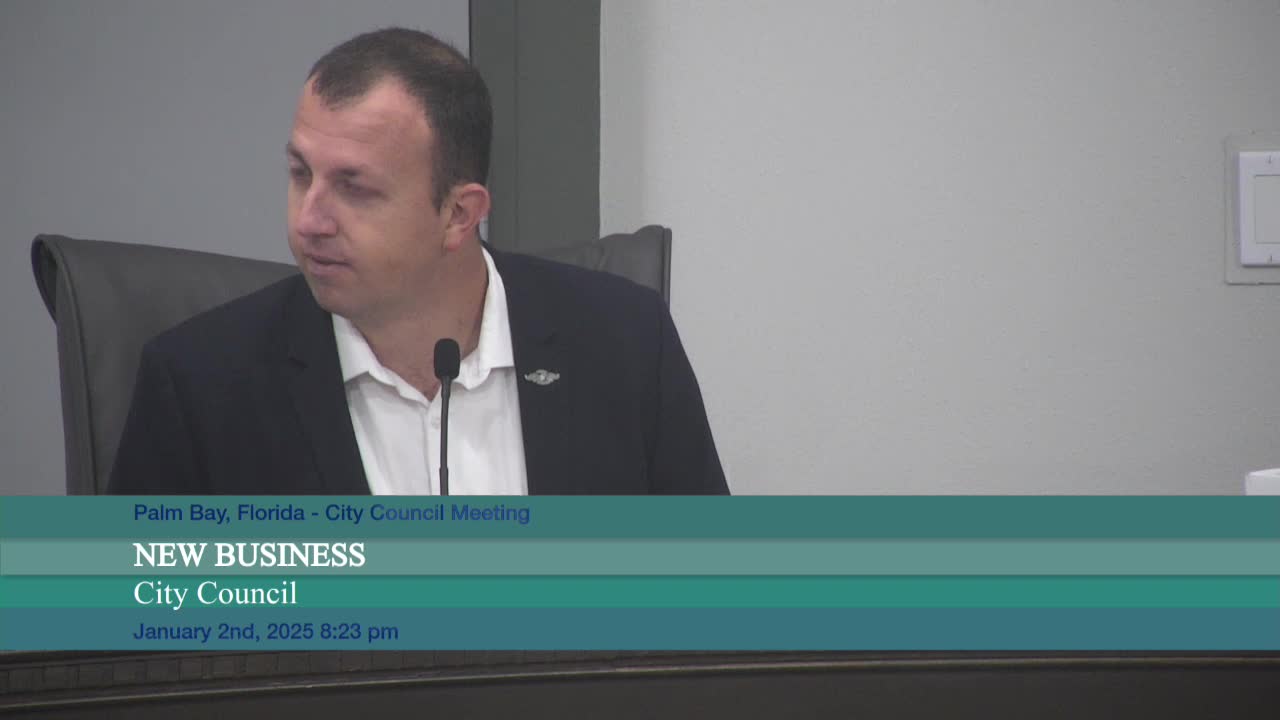Palm Bay council votes to keep fluoride out of drinking water and pivot infrastructure use
January 02, 2025 | Palm Bay, Brevard County, Florida
This article was created by AI summarizing key points discussed. AI makes mistakes, so for full details and context, please refer to the video of the full meeting. Please report any errors so we can fix them. Report an error »

The Palm Bay City Council voted 5-0 to formalize a decision not to add fluoride to the municipal drinking water and directed staff to pursue converting the partially installed fluoridation infrastructure for alternative use, such as feeding liquid ammonia for disinfection purposes.
The vote followed a staff briefing by the utilities director that the city’s fluoride feed systems at its two water plants have been offline since 2016–2017 and that earlier work to restore feeding infrastructure had paused while staff considered other uses for the equipment. The utilities director told council the data the city had collected during reviews indicated the retrofit could be converted to feed liquid ammonia — a different chemical used in some treatment processes — and that the servers and equipment being installed could be repurposed if council decides not to resume fluoridation.
Councilman Mike Langevin moved to formally continue the city’s current practice and to direct staff to transition the infrastructure to liquid ammonia if appropriate; Councilman Johnson seconded the motion. Langevin cited constituent concerns and state-level guidance and said the decision reflects community preference for voluntary, individual medical choices rather than blanket municipal dosing.
The council heard an extended public-comment period with more than a dozen speakers, including several dentists, medical practitioners and local residents. Speakers’ views varied: some urged continued fluoridation as a cavity-prevention measure, while others cited recent scientific reviews and a federal court ruling questioning EPA guidance and warned of possible neurodevelopmental risks from fluoride exposure. Dr. Warren Edwards, who said he is a dentist of 47 years, told the council, “Fluoride is a toxin. It's a neurotoxin,” and urged removal; other dental commenters urged targeted, clinical use rather than blanket dosing.
Utilities staff emphasized the practical and safety advantages of converting the planned delivery systems to feed liquid ammonia for disinfection chemistry rather than gaseous ammonia. Staff said the conversion is technically feasible and would not waste the investment in equipment being installed; the utilities director noted liquid ammonia is safer for operators than gaseous ammonia and that all feed systems are subject to standard engineering and safety reviews.
Council members asked staff to bring back any required technical and cost estimates for converting the equipment and to report regulatory implications. The vote was 5-0 in favor of the motion to stop fluoridation and pursue the conversion option.
The vote followed a staff briefing by the utilities director that the city’s fluoride feed systems at its two water plants have been offline since 2016–2017 and that earlier work to restore feeding infrastructure had paused while staff considered other uses for the equipment. The utilities director told council the data the city had collected during reviews indicated the retrofit could be converted to feed liquid ammonia — a different chemical used in some treatment processes — and that the servers and equipment being installed could be repurposed if council decides not to resume fluoridation.
Councilman Mike Langevin moved to formally continue the city’s current practice and to direct staff to transition the infrastructure to liquid ammonia if appropriate; Councilman Johnson seconded the motion. Langevin cited constituent concerns and state-level guidance and said the decision reflects community preference for voluntary, individual medical choices rather than blanket municipal dosing.
The council heard an extended public-comment period with more than a dozen speakers, including several dentists, medical practitioners and local residents. Speakers’ views varied: some urged continued fluoridation as a cavity-prevention measure, while others cited recent scientific reviews and a federal court ruling questioning EPA guidance and warned of possible neurodevelopmental risks from fluoride exposure. Dr. Warren Edwards, who said he is a dentist of 47 years, told the council, “Fluoride is a toxin. It's a neurotoxin,” and urged removal; other dental commenters urged targeted, clinical use rather than blanket dosing.
Utilities staff emphasized the practical and safety advantages of converting the planned delivery systems to feed liquid ammonia for disinfection chemistry rather than gaseous ammonia. Staff said the conversion is technically feasible and would not waste the investment in equipment being installed; the utilities director noted liquid ammonia is safer for operators than gaseous ammonia and that all feed systems are subject to standard engineering and safety reviews.
Council members asked staff to bring back any required technical and cost estimates for converting the equipment and to report regulatory implications. The vote was 5-0 in favor of the motion to stop fluoridation and pursue the conversion option.
View full meeting
This article is based on a recent meeting—watch the full video and explore the complete transcript for deeper insights into the discussion.
View full meeting